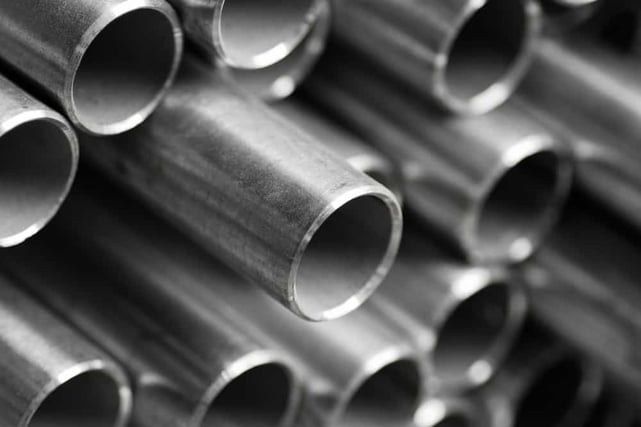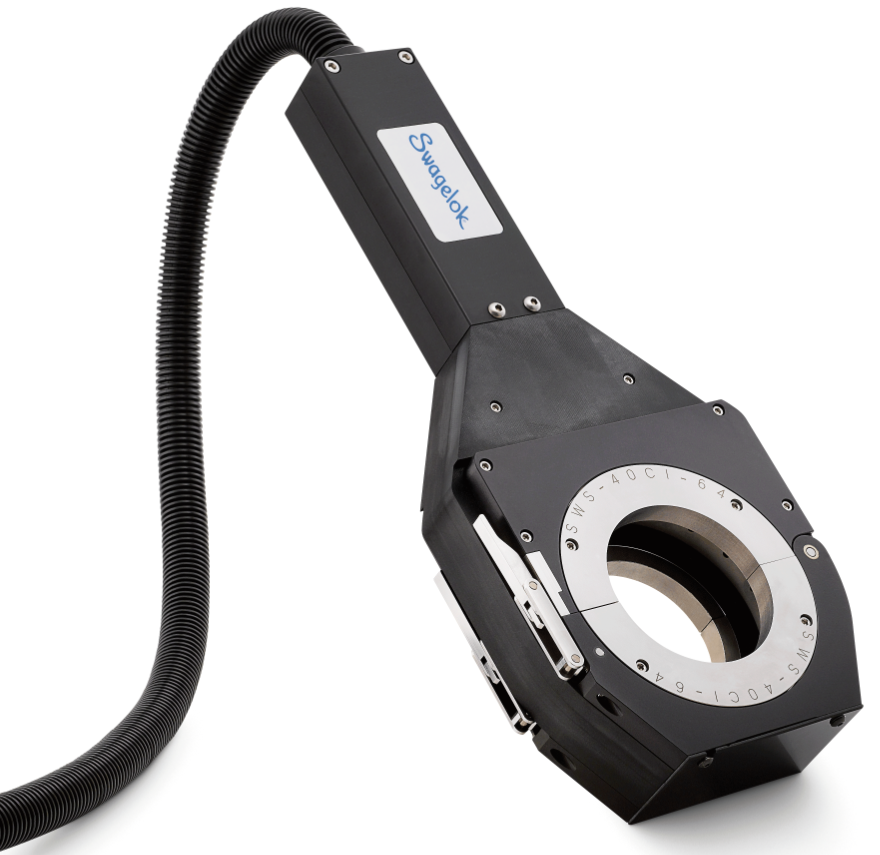Share this
TIG Weld Stainless Steel With Chill Blocks: Heat Management in Orbital Welding
by Jason Burns on 12/9/22 9:00 AM

Stainless steel and heat have a tricky relationship, high heat can cause a lot of issues. The effect is primarily observed in the form of rust and corrosion due to the loss of oxidation resistance. This is why the welding of stainless steel requires extreme control. This control can come in the form of precision input or the use of external thermal management components.
A chill block has been seen as an effective way to position and hold the workpiece steady during welding, while also ensuring heat management. Industries can also make use of external welding chillers along the workpiece to keep the heat in check.
Let's explore the different thermal management solutions used to improve the reliability of welds during orbital TIG (Tungsten Inert Gas) welding of stainless steel.
How Heat Affects Stainless Steel
When working with stainless steel tubes, industries expect tensile strength, corrosion resistance, temperature resistance, and metallurgical stability. However, when this metal is exposed to heat, some of its metallurgical properties change. Welding without proper control can lead to excess localized heating, evaporating away chromium as hexavalent chromium. This leads the stainless steel to be vulnerable to rust and corrosion.
Additionally, uneven application of heat when welding can cause the metal to distort, damaging its mechanical strength. In stainless steel, hydrogen cracking and embrittlement can also be major issues. This is the result of hydrogen diffusion into the metallic weld pool at high temperatures which creates cracks and voids during cooling.
Controlled heat input and careful heat minimization techniques during welding are effective solutions to these problems.
TIG Weld Stainless Steel with Chill Blocks
A unique feature of a TIG weld is that the process produces more heat through a narrow, concentrated arc compared to other welding forms such as the MIG (Metal Inert Gas). Therefore, it is important to note that the temperature does not exceed the interpass temperature (generally 150°C for austenitic stainless steel). Beyond this temperature, there is a high chance that the heat will burn through the backside of the workpiece, damaging it. As a preventive measure when TIG welding, the copper or aluminum chill blocks can be used as a heat sink.
Chill blocks are an effective heat management tool that holds the workpiece in place while absorbing excess heat. The advantage of TIG welding stainless steel with chill blocks are:
- Fast and effective cooldown of stainless steel welds to prevent overheating, heat distortion, or other weld defects
- Economic option compared to extensive cooling units
- Ideal positioning of the workpiece
By keeping the weld temperature within the specified heat parameter, these chillers facilitate high-quality welds of small-sized stainless steel tubings.
This feature is akin to orbital welding’s ability to precisely control the heat input. Chill blocks are not needed if you switch to orbital welding. The advanced welding system with parameter control is suitable for manufacturers to enhance their welding efficiency in a highly productive environment. When paired with external chillers, the results are sure to be of high quality.
Thermal Management with Orbital Welding of Stainless Steel

For a wide range of stainless steel tubing sizes, Swagelok offers appropriate weld heads and power supply solutions. This selection of components for orbital welding offers effective weld parameter control, including heat control and travel speed, so you do not have to worry about thermal management while working with critical stainless steel tubings. The power supply unit such as the M200 orbital welding system paired with the air- or water-cooled orbital weld heads, provides the right amount of heat input required for complete penetration. In addition, the weld head solutions also include cooling plates which dissipate the heat from the weld head to prevent excessive localized heating.
With Swagelok’s orbital welding solutions and external cooling systems, heat management will be precise and controlled for your TIG stainless steel welds.
To find out more regarding TIG welding stainless steel with chill blocks or other external cooling systems, and how Swagelok Northern California’s orbital welding solutions will help assure heat management for your fabrication process, contact our team today by calling 510-933-6200.
 About Jason Burns | Technical Services Manager
About Jason Burns | Technical Services Manager
Known to customers and Swagelok Northern California associates as the Swagelok Answer Man. Jason spends his work days answering customers' technical questions about Swagelok products and tools and training customers on how to install and use them.
Share this
- Archive (465)
- Assembly Services (207)
- About (100)
- Seal Support Systems (96)
- Best Practices (88)
- Training Services (74)
- Fittings (51)
- Semiconductor Applications (49)
- Hoses and Flexible Tubing (47)
- Regulators (44)
- Tubing (42)
- Grab Sampling Systems (32)
- Sampling Systems (32)
- Gas Systems (30)
- Services (30)
- Downloads (29)
- Valves (24)
- Application Support (18)
- Orbital Welding (17)
- Case Studies (13)
- Steam Systems (13)
- Frequently Asked Questions (12)
- Tools (12)
- Measurement Devices (7)
- Subsystems (6)
- Thermal Management (6)
- September 2023 (1)
- August 2023 (2)
- June 2023 (1)
- March 2023 (3)
- February 2023 (3)
- January 2023 (4)
- December 2022 (4)
- November 2022 (4)
- October 2022 (4)
- September 2022 (1)
- August 2022 (3)
- July 2022 (2)
- June 2022 (4)
- May 2022 (1)
- April 2022 (2)
- March 2022 (1)
- February 2022 (2)
- January 2022 (3)
- December 2021 (1)
- November 2021 (6)
- October 2021 (6)
- September 2021 (8)
- August 2021 (4)
- July 2021 (3)
- June 2021 (6)
- May 2021 (6)
- April 2021 (7)
- March 2021 (5)
- February 2021 (4)
- January 2021 (6)
- December 2020 (5)
- November 2020 (6)
- October 2020 (6)
- September 2020 (8)
- August 2020 (7)
- July 2020 (8)
- June 2020 (8)
- May 2020 (6)
- April 2020 (9)
- March 2020 (7)
- February 2020 (10)
- January 2020 (21)
- December 2019 (23)
- November 2019 (21)
- October 2019 (22)
- September 2019 (21)
- August 2019 (22)
- July 2019 (23)
- June 2019 (20)
- May 2019 (23)
- April 2019 (22)
- March 2019 (21)
- February 2019 (20)
- January 2019 (21)
- December 2018 (14)
- November 2018 (19)
- October 2018 (23)
- September 2018 (17)
- August 2018 (29)
- July 2018 (11)
- June 2018 (6)
- May 2018 (5)
- April 2018 (4)
- March 2018 (5)
- February 2018 (3)
- January 2018 (3)
- December 2017 (2)
- November 2017 (4)
- October 2017 (3)
- September 2017 (2)
- August 2017 (6)
- July 2017 (4)
- June 2017 (4)
- May 2017 (4)
- April 2017 (3)
- March 2017 (4)
- February 2017 (3)
- January 2017 (3)
- December 2016 (3)
- November 2016 (3)
- October 2016 (3)
- September 2016 (5)
- August 2016 (5)
- July 2016 (4)
- June 2016 (5)
- May 2016 (3)
- April 2016 (4)
- March 2016 (5)
- February 2016 (11)
- January 2016 (1)
- December 2015 (3)
- November 2015 (4)
- October 2015 (3)
- September 2015 (4)
- August 2015 (4)
- July 2015 (8)
- June 2015 (5)
- May 2015 (3)
- April 2015 (4)
- March 2015 (4)
- February 2015 (3)
- January 2015 (4)
- December 2014 (2)
- November 2014 (3)
- October 2014 (4)
- September 2014 (4)
- August 2014 (4)
- July 2014 (5)
- June 2014 (4)
- May 2014 (4)
- April 2014 (5)
- March 2014 (4)
- February 2014 (3)
- January 2014 (4)
- December 2013 (5)
- November 2013 (3)
- October 2013 (4)
- September 2013 (3)
- August 2013 (5)
- July 2013 (5)
- June 2013 (5)
- May 2013 (3)
- April 2013 (6)
- March 2013 (4)
- February 2013 (4)
- January 2013 (8)
- December 2012 (4)
- November 2012 (6)
- October 2012 (6)
- September 2012 (4)
- August 2012 (4)
- July 2012 (4)
- June 2012 (4)

.webp?width=210&height=70&name=StickyLogo%20(5).webp)